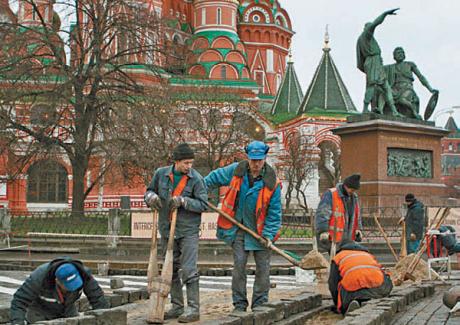
Russia’s Failing Economy Likely to Drive Migrant Laborers Into ‘Foreign Legion’
Publication: Eurasia Daily Monitor Volume: 12 Issue: 33
By:

On February 2, Tajikistan’s government approved an “anti-crisis program” designed to stimulate economic growth by creating 200,000 new jobs (Ozodi, February 2). While the details of the stimulus plan are uncertain, the causes of Tajikistan’s current economic woes are clear. In particular, the Russian economic crises and the devaluation of the ruble, caused by a combination of Western sanctions and low oil prices, have hit Tajikistani migrant laborers in Russia hard. Conservative estimates put the number of Tajikistani migrants in Russia at one million, and their combined remittances account for nearly half of Tajikistan’s GDP, making it the most remittance-dependent country in the world. Analysts predict that if the ruble stays in its current slump, remittances could decrease by up to $2 billion—or 25 percent of the Central Asian country’s GDP (Ozodi, February 2). Aside from lowering workers’ wages, the fall in the ruble has also devalued Tajikistan’s own currency (the somoni), despite the efforts of the Central Bank to stabilize it with the bank’s dwindling cash reserves (Nahzat, December, 26, 2014). Thus, migrant laborers are sending less money home, and their money is not going as far.
Moscow’s new immigration policies are compounding the problems faced by migrant workers. Effective January 1, Tajikistani migrants are now required to hold a foreign passport and pass a Russian-language test when applying for a work permit (see EDM, November 26, 2014). Not only do many migrants not hold foreign passports, but obtaining one can be cost prohibitive. A foreign Tajikistani passport officially cost $100; but unofficially, it is widely reported to cost $400–500 when the requisite bribes are included (Nahzat, December, 26, 2014; Ozodi, January 1, 2015). Last year, even before these new regulations took effect, over 200,000 Tajikistani migrants were deported or denied entrance to Russia (BBC Tajik, September 24, 2014). The combination of lower wages, more expensive bribes, and stricter immigration policies are now causing many to recalculate the costs and benefits of going to Russia for work.
However, even as it clamps down on immigration, Moscow is making it easier for foreigners to join the Russian military. On January 2, Vladimir Putin signed legislation allowing foreigners aged 18–30 to serve five-year contracts in the Russian military, provided they speak Russian and have no criminal background (Moscow Times, January 7). According to Radio Free Europe, soldiers serving in Russia’s “Foreign Legion” are paid $500 a month (more than the average wage of a migrant laborer), but are more likely to be deployed to conflict zones (Radio Free Europe, January 6).
Representatives of migrant laborers in Russia have welcomed this legislation and predict that “thousands” of Tajikistanis will likely sign up (Radio Free Europe, April 16, 2014; Ozodi, January 3, 2015). Concrete metrics of the number of migrants applying to join the military are difficult to come by. However, in a press conference on February 5, a Russian military official announced that in the oblast of Tyumen alone, six Tajikistani citizens have already signed contracts and another 10–15 have applied (Ozodagon, February 5). On February 7, the head of Tajikistan’s parliamentary Committee on Legislation and Human Rights confirmed that it is lawful for citizens of Tajikistan to serve in the Russian military. Currently Tajikistani law bans citizens from fighting in foreign conflicts, but this law is targeted at preventing Tajiks from joining Islamic groups in Syria, Iraq and Afghanistan (IRIB Tajik, February 7).
Russia’s decision to allow foreigners to serve in the military will allow it to engage in hostilities abroad while mitigating potential domestic backlash. While Russia’s aggression in Ukraine stirs nationalist sympathies in certain segments of Russian society, a protracted quagmire involving significant Russian casualties could sour public opinion as happened during the Soviet invasion of Afghanistan. Migrant laborers, however, are routinely discriminated against in Russia and, as soldiers, will likely be used as disposable cannon fodder. Reports already exist of Tajikistani mercenaries fighting in eastern Ukraine, with at least one confirmed death (Ozodi, January 8). On December 22, a Russian news site posted a video of a Tajik man bragging about fighting with pro-Russia militias in Ukraine and claiming to know many more Tajiks who wanted to come fight (36on.ru, December 22, 2014). The establishment of the Russian Foreign Legion will institutionalize and expand this practice of employing citizens of former Soviet countries to fight in conflicts zones that require Russia to maintain a veneer of plausible deniability.
In the short term, Russia’s failing economy will likely drive military recruitment of migrant laborers faced with bleak employment options. And equipped with a growing number of disposable soldiers, Putin could be emboldened to increase Russian’ military involvement in Ukraine, Abkhazia, Transnistria or even Syria. This is especially ironic given that Putin’s bellicosity is the reason for the sanctions that have contributed so much to Russia’s economic malaise in the first place. If these predictions prove correct, then Russia’s economic problems may actually fuel Putin’s aggression rather than discourage it.




